Key Documents Hearings – Part 2
In today’s hearing at the ECCC, key document presentations ran, in comparison to last week’s disagreements, smoothly. The Co-Prosecution and Civil Party Lead Co-Lawyers presented key documents related to 1st January Dam, Kampong Chhnang Airfield construction worksite and Trapeang Thma Dam, while both Defense Teams for Nuon Chea and Khieu Samphan maintained their position not to present their documents. The Khieu Samphan Defense Team will react to the Co-Prosecution’s documents on Monday, which the Nuon Chea Defense Team declines to do.
1st January Dam
At the beginning of the session, the Trial Chamber Greffier confirmed the presence of all parties, with Nuon Chea following the hearings from the holding cells.
At this point, the Co-Prosecution was granted the floor.
First, Senior Assistant Prosecutor Vincent de Wilde clarified the passages where young adolescents could be seen in the video.[1] Second, he indicated the proof of death of the witness’s written record of interview that gave rise to heated discussion last week.[2]
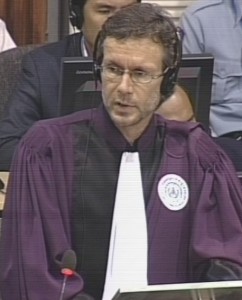
Senior Assistant Prosecutor Vincent de Wilde
He then continued with a Written Record of Interview that he had started to present last week Wednesday[3] This witness was also present at a technical school like the witness of another interview that was presented last week. He stated that he followed his father to the 1st January Dam.[4] In his interview, he talked about working conditions, food shortages and a lack of medicine.[5] Lastly, the witness indicated that there were visits of high-ranking officers visiting the worksite.[6]
Mr. de Wilde then presented document E3/5264, which is the Written Record of Interview of a deceased member[7] of Ke Pauk’s family. He was the nephew and driver of Ke Pauk and stated that Ke Pauk had visited the worksite and that his office was six to seven kilometers from the worksite.[8] Furthermore, according to this witness, people were afraid of Ke Pauk and people were killed because of minor offences. This witness also talked about hygiene, stating that there was not sufficient water.
The next document was E3/9349, which is the WRI of a witness who worked for two weeks as a deputy head of a mobile unit and as a chief of guards on the guards at Bridge 4 at 1st January Dam.[9] He was instructed by his village chief to monitor the workers. Further, he had stated that he did not personally see killings, but that he saw how the heads of mobile units blindfolded 17th April People, who were then let away.[10]
In Written Record of Interview E3/5287 of the uncle of the previous witness, detention conditions in a Security Center in Baray District were described, which was related to the 1st of January Dam Worksite. Vehicles came from this dam to the center every one to two days, and from 1978, when the Southwest Zone Cadres took control, more often.
This led Mr. de Wilde to his third subject, after having covered general information on hydraulic projects and living and working conditions last week and today. His third subject covered the evidence of purges.
In document E3/2782[11], an interview titled ‘Ke Pauk’s Autobiography’ from 1986, Ke Pauk stated that he went to Phnom Penh in 1977 to meet Pol Pot and Nuon Chea, who showed him documents from all the regions and ministries.[12] This indicated that the chief of ministries[13] and the chief of a rubber plantation were arrested in 1977. Moreover, this document suggested that there were arrests of military commanders, and that the first wave of arrests of completed in June 1977.[14] This was confirmed, according to Mr. de Wilde, by the list of S-21 prisoners, except that the number of arrested cadres was higher.
This list[15] showed the names of 94 names of prisoners at S-21 from the North Zone that arrived at the prison between February 1st and March 27th 1977.
At this point, Mr. Kong Sam Onn interrupted, clarifying that with regards to the term “ministry” that Mr. de Wilde understood as meaning “regional office”, also the Khmer Version of the document read “ministry”.
Mr. de Wilde then continued the presentation of the prisoners’ list and pointed out specific names[16] that were cadres from the Regions 41, 42 and 43 and from other districts. The next document[17] showed the registration of executions of S-21, including names and ranks of prisoners.
E3/2166: was another list, which showed the name of the second chief of the works at 1st January Dam, namely Sao (also spelled Sor), also known as Yap or Youn. The imprisonment of this person had already been mentioned in E3/6414. Lastly, a list of S-21 prisoners of November 1977 showed a number of North Zone cadres being imprisoned there.[18]
Mr. de Wilde then turned to the next document[19], which was titled ‘The Double-faced Mirror’ and was to be found in the Information Bulletin about Cambodia, October/November 1978, which indicated that foreign delegations visited the 1st January Dam site. The author was most likely Ponchaud.
Mr. de Wilde then provided a list of foreign delegations and the dates of their visits. These visits included delegation from North Korea[20], Romania[21], Lao[22], Denmark[23], Belgium[24], Sweden[25], France[26], Japan[27], Norway[28], West Germany[29], China[30] and the delegation of Prof Caldwell, R. Dudman and E. Becker[31]. These visits took place between February 1977 and December 1978.
Judge Jean-Marc Lavergne interjected and asked whether it would be possible to get the ERNs in advance.
At this point, Civil Party Lead Co-Lawyer Pich Ang took the floor. With regards to the 1st of January Dam he presented five documents and one video.
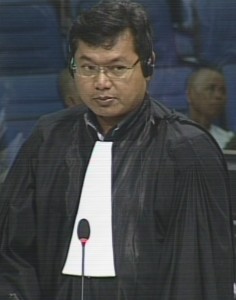
Civil Party Lead Co-Lawyer Pich Ang
First, Mr. Ang presented Civil Party Application E3/6850 of a person[32] who worked at 1st of January Dam worksite from 1976 to 1977. He described the working and living conditions at the dam. Second, another Civil Party Application indicated the living conditions at 1st January Dam and what happened if someone was involved in “moral misconduct” there. Third, Civil Party Supplementary Information Sheet E3/6324 gave insight into the experience of a woman who was assigned to work at the 1st January Dam, because she “refused to get married.”[33] She further described working and living conditions.[34] Fourth, the Supplementary
Information Sheet of Koeung Rhun E3/68A reflected upon the working conditions at the worksite and stated that around three hundred children worked there.[35]
Fifth, the Written Record of Interview of a witness, E3/9350, described the working and living conditions at the dam.[36] The witness stated that there was no sanitation, and the medics on standby gave rabbit dropping pills to those who were sick. According to this witness, one worker died from illness and workers were emaciated.[37] Lastly, Mr. Ang presented a short extract of a video that was also presented by the Prosecution last week. This video showed, according to Mr. Ang, the lack of proper clothes at the worksite as well as young people working at the First January Dam.
At this point, Mr. Kong Sam Onn took the floor, stating that he would strongly object to the description of the video clip that Mr. Ang gave before having shown the clip. Mr. Ang replied that he gave this description to bring the attention of everyone to the specific issues.
After a discussion on the presentation of the video, the President gave leave to present the document.
Kampong Chhnang Airfield
After the first break, the President gave the floor to the Co-Prosecution to continue their presentation. Deputy Co-Prosecutor William Smith started the presentation of the documents related to Kampong Chhnang Airfield Construction Site and stated that he would present 29 documents.
During this session, Mr. Smith presented his documents, including contemporaneous documents, such as minutes of CPK Standing Committee Meetings, as well as written records of interviews of people who participated in the construction of the Kampong Chhnang Airfield.
The first documents[38] served to point out the time of planning and construction of the airfield. Moreover, Mr. Smith highlighted that this situated Kampong Chhnang as part of an overall plan of the Central Committee and that the notion of a “class enemy” was also deeply entrenched in Division 502, which was sent to Kampong Chhnang. A few of the first documents also highlighted, according to Mr. Smith, the awareness of Nuon Chea and Khieu Samphan about the construction of the airfield, since they were present in a number of meetings that discussed the matter.
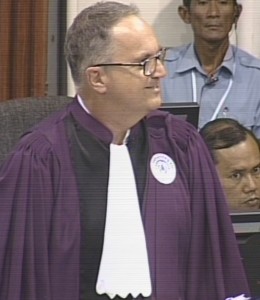
Deputy Co-Prosecutor William Smith
Another document, E3/13 of 9th October 1976, entitled “Minutes of the Meeting of Secretaries of Divisions and Independent Regiments” showed, according to Mr. Smith, that the commanders had the intent to purge soldiers in general. This meeting was chaired by Son Sen. At this meeting, the commander of Division 502 Sou Met, who stated that the “elimination of enemies” was “imperative” to strengthen the party politically, ideologically and organizationally.[39] Thus, Mr. Smith stated that the person responsible for the construction of Kampong Chhnang airfield was also actively involved in purges.[40]
The next group of documents Mr. Smith presented was Written Records of Interviews by witnesses who had worked at Kampong Chhnang, for example as members of Division 502 between late 1976 and 1978.[41] These described working and living conditions, the deaths of people as well as the authority structure at the dam and served, in Mr. Smith’s view, to prove crimes that were part of the indictment related to Kampong Chhnang.
Written Record of Interview of Chouk Rin E3/362 was relevant, according to Mr. Smith, because it was the interview of a person who was a battalion commander in the Southwest Zone from 1975 and 1977 and a regiment commander of Centre Division 703, who had been instructed to purge cadres.[42] According to Mr. Smith, this WRI shows that East Zone cadres had been sent to Kampong Chhnang airport. This witness stated that there was a meeting, in which Pol Pot, Nuon Chea, and Ieng Sary planned to purge cadres, which were sent to S-21 later. Further, the witness testified about meeting at Ta Mok’s house, where commanders decided on sending soldier to Kampong Chhnang: 1,000 from Takeo, 700 from Kampot, and 700 to 800 from Kandal.[43] The same witness stated in another interview that Nuon Chea ordered arrests and that the term ‘purge’ meant to arrest and kill.[44]
Mr. Smith then proceeded to present other documents relating to soldiers being sent to Kampong Chhnang, including documents that seemed to indicated that there were at least 2 600 people working at the airfield that did not include Division 502 or other divisions.[45]
Turning back to Written Records of Interviews, Mr. Smith again presented documents that related to the working and living conditions, disappearances and killings of workers at Kampong Chhnang, as well as the treatment and killings of workers who came from the East Zone in particular.[46]
At this point, the President adjourned the hearing for a break.
Rescheduling of the Hearings
After the break, International Defense Counsel for Khieu Samphan Anta Guissé requested to be able to address the key documents presented by the Co-Prosecution on Monday. She stated that the Nuon Chea Defense team had informed her that they did not intend to present documents. Thus, she asked whether it was possible to hold the hearings as originally scheduled.
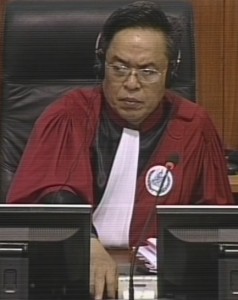
President Nil Nonn
Judge Lavergne asked to clarify whether both defense teams did not intend to present key documents. He asked whether the defense team for Nuon Chea intended to react to the presentation by the Co-Prosecution and Civil Party, which International Nuon Chea Defense Counsel Victor Koppe denied.
The President granted the request and stated that Monday morning, the floor would be given to the defense team of Khieu Samphan to react to the key documents presented by the Co-Prosecution.
Mr. Smith took the floor and stated that he would not have sufficient time to fully present the documents for all worksites. He would, however, provide a summary of the documents and requested that the list they had provided to the parties in advance would be used as a guidance of importance of documents in evaluating evidence.
First, they had presented letters and telegrams from Sou Met to Duch this morning[47] to show that Sou Met was actively involved in purges without any legal justification from Kampong Chhnang airfield and other places. They also support witness testimonies about re-education and re-fashioning of Division 502 at Kampong Chhnang.
Second, according to Mr. Smith, a number of documents demonstrated the purge of division 170.[48] Third, a document served to give evidence of enslavement of soldiers or workers.[49] Fourth, Mr. Smith presented a number of documents related to the treatment of East Zone detainees, who were taken to Kampong Chhnang.[50] Mr. Smith then summarized the importance of the documents by stating that they showed that the purpose of the airfield was twofold: on the one hand, to defend themselves against external enemies. On the other, to defend themselves against internal enemies by re-educating and re-fashioning some of the builders of the airfield. According to Mr. Smith, the internal enemies were considered to be a greater threat than the external enemy. Thus, the documents showed the two-fold approach of “building while purging.”
At this point, Lead Co-Lawyer Pich Ang started his presentation of two civil party applications that relate to the Kampong Chhnang Airfield. Both Civil Parties were minors when they were sent to the Kampong Chhnang airfield construction site when they were around fifteen years old.[51] The first Civil Party application related to the working conditions and the number of deaths at the worksite. The second Civil Party application also related to work conditions as well as arrests and disappearances. With this, Mr. Ang finished his presentation of key documents related to Kampong Chhnang Airfield.
Trapeang Thma Dam
Senior Assistant Prosecutor Travis Farr then started the key documentation presentation relating to Trapeang Thma Dam. The first document he presented was E3/771 of July/August 1977, which was a Revolutionary Youth Magazine[52], entailing a description and location of the worksite. The description is, according to Mr. Farr, consistent with the site identification report.[53] Moreover, the document also discussed the work conditions. The Revolutionary Youth Magazine stressed the hard working conditions, but stated that “brothers were happy”. According to Mr. Farr, this document showed the awareness of the leadership about the construction site, that the dam was built to “achieve the center’s plan” and that there were thousands of workers. Another document situated the Trapeang Thma Dam project in the general policies of the CPK.[54] The next document Mr. Farr presented was a book by Khieu Samphan entitled “Cambodia’s Recent History: and the Reasons behind the Decisions I Made”[55], where Khieu Samphan discussed having seen the Trapeang Thma Dam water reservoirs. The same was indicated in an open letter from Khieu Samphan,[56] which showed Khieu Samphan’s knowledge about the project and the extent of it.
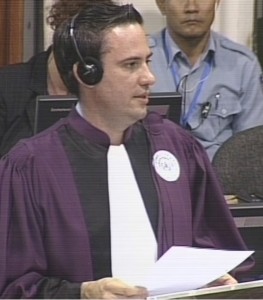
Senior Assistant Prosecutor Travis Farr
Next, Mr. Farr presented contemporaneous documents, such as reports from the Sector 5 Committee and telegrams, where the situation and progress made at Trapeang Thma Dam was described.[57] The telegrams mentioned food shortages and asked for advice. These documents indicated, according to Mr. Farr, that the center was aware of the situation at the dam as well as the hierarchy of people responsible for the construction of the dam.
Mr. Farr the continued to present a Chinese Press Agency News Report of early December 1977,[58]which reported on the visit of Chhing Young Huy and showed that the dam was built in response to an order of the central party committee, the conditions at the dam, and that 20,000 people were engaged in its construction. Similarly, a domestic press service report from Phnom Penh described the project and visits at the reservoir.[59] The next document was a Revolutionary Flag Magazine from April 1978,[60] which talked about the visit of Yugoslav journalists at the dam and the duration and scale of Trapeang Thma worksite project.
Next, Mr. Farr turned to presenting a number of Written Records of Interviews.[61] These documents indicated the working and living conditions and the increase of arrests and killings of people under the control of the Southwest Zone cadres. One of these stated that two women had been raped and killed and that living conditions were more difficult after the Southwest Zone cadres arrived at Trapeang Thma dam.[62]
In the last session of today’s hearing, Mr. Farr continued the presentation of documents. The first document he presented was an organization chart of the leadership in Sector 5 of the Northwest Zone that gave an overview about the number of people living in Phnom Srok District and Preah Net Preah District that indicated an increase in the number of people living in these areas after 17th of April 1975.[63] Another document gave the background information, listing districts and communes in Sector 5.[64]
The next category Mr. Farr presented were S-21 prisoners’ lists that indicated the number of prisoners that came from the Northwest Zone and showed a number of cadres that were sent to this prison from Sector 5, including their date of entry and the day they were killed.[65] Mr. Farr pointed out the arrest of specific cadres. In the next group of documents, Mr. Farr pointed to the arrest of specific cadres, namely Ta Hoeun[66], Ta Rhing[67], Ta Hat[68] and Ta Maung[69]
At this point, Ms. Guissé objected to one of the documents[70], which was not on record. Mr. Farr withdrew comments to this document. Later during the session he provided the new references of the document; it was admitted as E3/7366. The next documents that Mr. Farr presented related to the change in authority structure
in Sector 5 and Trapeang Thma dam.[71]
With this, Mr. Farr concluded his presentation and gave the floor to the Civil Parties Lead Co-Lawyers.
Mr. Pich Ang presented four Civil Party Applications.
The first Victim Information Form related to the working conditions at Trapeang Thma and the mistreatment of the civil party at this worksite.[72] The second Victim Information Form also related to the working and living conditions at the worksite and mentioned the arrests and killings of workers if these did not fulfill work quotas.[73] The third and fourth civil parties that Mr. Ang presented showed the authority structure at the dam as well as working and living conditions and the lack of food.[74] With this, Mr. Ang finished his presentation.
The President took the floor and stated that the Chamber had received a notification that the Defense Counsel for Khieu Samphan objected to the testimony of witness TCW-987 relating to the treatment of Cham. Asked for clarification, Ms. Guissé stated that this witness had not been listed as a potential witness in Case 002 and had not been interviewed by the Co-Investigative Judges for Case 002, but only for another investigation. Thus, the Defense Counsels stated that Khieu Samphan’s rights would be violated on the basis that he would not be able to defend himself properly, since this witness had not been interviewed for the particular case. “It’s an issue of principle.”
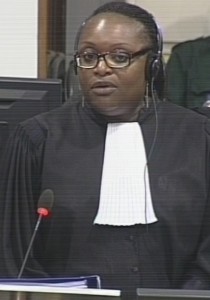
Khieu Samphan Defense Counsel Anta Guissé
Judge Lavergne stated that Ms. Guissé was referring to general principles and the civil law system and asked her to specify the legal rules. Ms. Guissé replied that in this Chamber’s decision to call this witness, the Chamber relied on rule 87(4) to admit new evidence – which was legal under these internal rules. However, in terms of the process there was a grave problem with regard to the right to fair trial by the defense.
Mr. Lavergne replied that the Written Record of Interview of this witness was made available on 20 March 2015, which gave the Defense sufficient time to prepare.
Ms. Guissé replied that this person had not been subject to rule 87(4).
Mr. de Wilde took the floor, stating that the defense had received access to the Written Record of Interview in March and no defense team had objected at that time. The relevant documents were only two Written Records of Interviews with 15 pages.
Civil Party Lead Co-Lawyer Marie Guiraud replied that she requested an oral submission on Monday to be able to read the submission filed by the Khieu Samphan defense.
Mr. President announced the scheduling of hearings next week.
Ms. Guissé interjected and stated that the number of pages should not be decisive, since information had to be cross-checked with other witnesses. She asked: “Is it normal that we suddenly decide that there is another investigation” once a closing order had been issued and the trial had been started. She stated that this was a fundamental problem.
The President announced that there would be a ruling “in due course.” The Chamber ruled on the request by the Co-Prosecutors to reply to the response made by Khieu Shamphan’s Defense team made on the 22nd of August 2015 and decided that the Co-Prosecution would not be given any opportunity to reply.
The President adjourned the hearing and stated that the hearings would resume Monday, August 7, 2015, with the testimony of TCW-813.
[1] E3/040R, passages: 0:16-0:17, 1:029-0:30; 3:56-3:57 [2] Yeng Chan D128/68. [3] E3/35, also deceased: E144/1/1.1 [4] E3/35, at 00367721 (FR), 00346149-50 (ENG), 00340563 (KH) [5] ENG: questions 63-64 [6] 00367722 (FR) 00346151 (ENG) 00340564 (KH). [7] E21/471 [8] 5-6 in Eng, 5 in Fr, 6 in Kh [9] in Fr, 3-4 in Kh, 4, in Eng. [10] 5 in FR, 5 in KH, 4-5 in ENG. [11] Which is also listed as E3/2783. [12]E3/2782, at 00596210 (FR), 00089713 (ENG), 00164130 (KH). [13] Mr. De Wilde stated that the term “ministry” should in fact be understood as “regional office”. [14]E3/2782, at 00596211 (FR) 00089713-14 (ENG) 00164131-33 (KH). [15] E3/2956 [16] Number 10, 56, 57, 81 and 82 on the list. [17] E3/3861 [18] E3/165 [19]E3/2410 [20] E3/284 00168413 (ENG) , February 1977 and Visit of deputy minister of North Korea No E3/293 at 00169739-40 (ENG). [21] 5th Apr 1977 E3/286 00168194 (ENG) and E3/295, at 00169858 (ENG). [22] E3/286: 20th April 1977 00701453-54 (FR) 00168253 (ENG) 00681225-26 (KH). [23] E3/755: Marxist of Danish delegation 4 August, at 00168945 (ENG). [24] Cambodian Belgian delegation August 1978, at 00168491. [25] Swedish Cambodia friendship delegation end August 1978 01074580 (FR) 00169017 (ENG) : thousands of peasants were endeavoring to complete 6th Jan Dam Project. [26] E3/76: visit from French communist party & delegation of “the idealist?” 13 sep 1978 00170396 (ENG). [27] E3/76 same doc: Japan Cambodia Friendship 00170431 (ENG), and E3/295, 11 Dec Japanese delegation, at 0016918-19. [28] E3/294: Norwegian Com party 00170186 (ENG). [29] E3/295: 5 visits West German Com Party led by Dürer 00169084 (ENG). [30] E3/295. [31] E3/295 Dutman, and Becker, at 00169169 (ENG). [32] E3/6850, at 00570948 (KH), no English translation. [33] E3/6324, at 00580542 (KH) 00866864 (eNG) 01132692 (FR). [34] E3/6324, at 00533402 (KH), 00106660 (ENG). [35] E3/68A, at 00588431 (FR) no English translation. [36] E3/9350, at 00299949, 00274344 (FR) 00244169-70 (ENG). [37] E3/9350, at 00239951 (KH) 00244170 (ENG) 00274345 (FR). [38] E3/182 of 9 October 1975: CPK standing Committee Meeting Minutes 00183407 (ENG) 0019126 (KH) 00292886 (FR) ; E3/1139: 22nd Jan 1976; E3/229: 22nd February 1976: Standing Committee Meeting Minutes, at 00182627 (ENG), 00000716 (KH) , 00334960 (FR); E3/236: 19-21 April 1976: Standing Committee Meeting Minutes, at 00183419 (ENG) 00019145 (KH) 00322970 (FR); E3//222: 15th May 1976: Standing Committee Meeting Minutes, at 00182666 (ENG), 00000771 (KH) 00323892 (FR). [39] E3/13, at 00940350 (ENG), 00052411 (KH), 00334980 (FR). [40] See also E3/13, supervisor 00940354-55 , 00052414 (KH) 00334982-83 (FR), where Son Sen (who was Sao Met’s immediate superior), classified internal enemies in three categories: “dangerous”, “ordinary liberal category” and those who “merely believed in the enemy’s incitement.”; for other documents related to purges see also E3/804 ‘Minutes of Meetings of RAK’ , 15 December 1976, at 00233718 (ENG), 00008478 (KH), 00386208 (FR); E3/807: 1 March 1977 RAK Divisional and General Staff Meeting Minutes , at 00933834 (ENG) 00052304-05 (KH) 00323922; E3/1140: 1 April 1977 : Report from Sou Met (commander of division 502) to Duch at S-21. [41] E3/5279, at 00293008-10(ENG) , 00287548-51 (KH) 00342677-79 (FR); E3/5263, 00282224-25, 00270178-80 (KH), 00283349-51 (FR). [42] 00268895 (ENG), 00210209 (KH) 00268903 (FR). [43] 00268896-97 (ENG) 00210211-12 (KH) 00268904-05 (FR). [44] E3/361, at 00766457 (ENG), 00194471-72 (KH), 00268889-90 (FR). [45] E3/849 RAK Report dated 7th April 1977; for purges, the Co-Prosecution submitted documents: E3/970, 30th May 1977 Report of Sou Met to Duch at S-21 [46] E3/7877, at 00346979 (ENG) 00342437 (KH) 00411785-86 (FR); E3/5276, at 002873356 (ENG), 00282954-55 (KH) 00339922 (FR); E3/3959, at 00278685 (ENG) , 00270168 (KH) 00486100 (FR) and 00278686-87, 00270169-70 (KH) 004826101(FR); E3/3962, at 00293367-69 (ENG), 00287538-40 (KH) 00355875-78 (FR). [47] E3/1054, 1st June 1977; E3/9383; E3/1050 2nd June 1977; E3/1151 28 July 77; E3/1040, 10th August 1977; E38385 October 1977; E3/1087 3rd October 77. [48] E3/1182, Military Report from Ung Ren dated 6 July 1978; E3/369, Written Record of Interview. [49] E3/1094, Zone Report from Office 41 (West Zone), 4th August 1978. [50] E3/7893 Written Record of Interview; E3/7894 Witten Record of Interview. [51] E3/4694, at 00565048 (KH) 00398344 (ENG) 00909841 (FR); E3/6427A at 00581529 (KH) , no English or French translation available. [52] 00509685-87 (ENG) , 00376343-45 (KH) 00594052-55 (FR). [53] E3/8050, at 00428005 (ENG)( 00464720 (KH) 00450434 (FR). [54] E3/300 Voice of Kampuchea Newsbroadcast from Phnom Penh; S00704541 (KH) S0070280 (ENG) S0006803 (FR). [55] E3/18, at 00103780 (ENG) , 00103878 (KH), 00595487 (FR). [56] E3/592, at 00002803 (ENG) 00623766 (FR) 00002799 (KH). [57] E3/178: weekly report of sector 5 committee, 21 May 1977, at 00342719 (ENG) 00275596 (KH) 00623317 (FR); 00342709 (ENG) 00275587 (KH) 00623305 (FR) and 00242711 (ENG) 00275589 (KH) 00623307 (FR); E3/719 Report dated 29 May 1977, at 00183016-17 (ENG) 00008501 (KH) 00236772 (FR); E3/950 Telegram by Nhim to Angkar 870 dated 11 May 1978, at 00185215-18 (ENG) 00021043-45 (KH) 00296221-23 (FR); E3/863 Telegram by Nhim to Angkar dated 17 May 1978, at 00321961 (ENG) 00623408 (FR) 00076286 (KH). [58] E3/1783, at 00498180-81 (ENG) 00659259-60 (KH) 00606766 (KH). [59] E3/1339, at 00168341 (ENG). [60] E3/4604: Revolutionary Flag Magazine April 1978, at 00519843 (ENG), 00064727 (KH), 00519843 (FR). [61] E319/19.3.33, at answers 9 and 10; E319/21.3.5 at answers 27 and 28; E319/19.3.47, at answers 13 and 18; E319/19.3.24, at answer 19. [62] E319/21.3.3, at answers 93 and 94. [63] E3/1181 “General View of Sector 5 Northwest Zone” 20th Jun 1977, at 00223175 (ENG) 00612290 (FR) 00214487 (KH) and00223176 (ENG) 00214490 (KH) 00612291 (FR) . [64] E3/9284, at 01046931 (EN); 00214495 (KH), no French translation available. [65] E3/1900, List of prisoners smashed on 6 August 1978; at 00193556 (ENG), 00909168 (FR), the corresponding Khmer version is E357.1 at 01128615; E3/3972 Monthly List of prisoners from the North Zone and West Zone, at 00837611 (ENG) 00086932 (KH) 00864731 (FR); E3/2285 Compilation of list of those who were smashed on 18th October 1977, at 00873633 (ENG) 0009303 (KH). E3/2254 at 00789707 (ENG), 00086766 (KH), 00834853 (FR); E3/342 at 00329817; 00329701; 00329599; 00329863; 00329598 (in all languages). [66] E3/2474 [67]E357.4 [68]D159/5.61 [69] E3/7395 [70] D159/5.61 [71] E3/8991, at 00969903 (ENG) 00730232 (KH); E319/19.3.46 at answer 42 and 43; E3/7805, Written Record of Interview, at 00277815 (ENG) 00267743 (KH) 00315174 (FR) and 00277817 (ENG) 00267746 (KH) 00315177 (FR). [72] E3/6543 at 00553167 (KH), no translations available. [73] E3/6382, at 00540480 (KH), no translations available. [74] E3/6391 at 00540623 (KH), no translation; E3/6630 at 00558119 (KH), 01069323 (ENG), no French translation.
